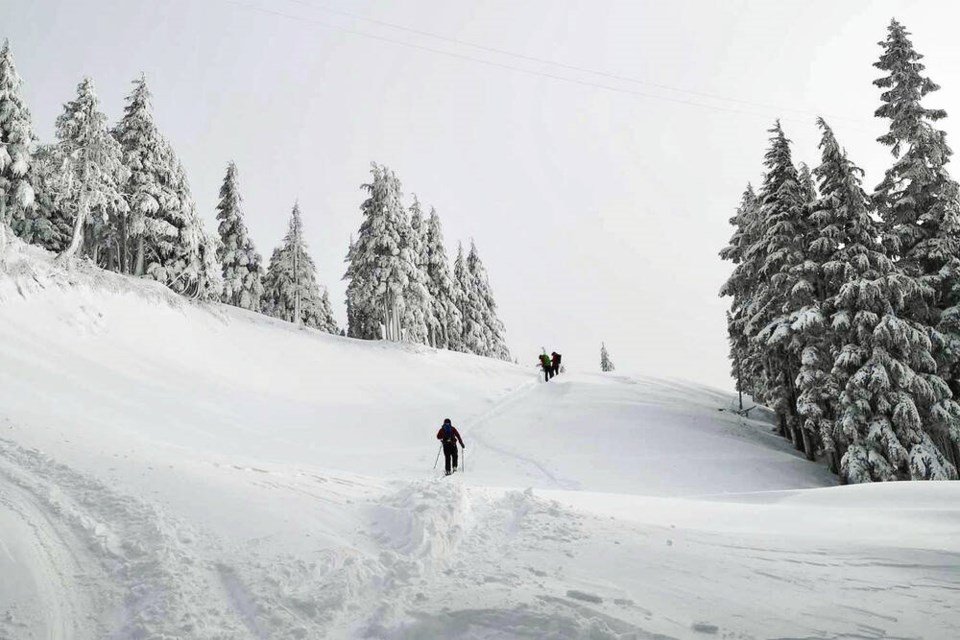Interest in backcountry skiing and snowboarding has been steadily increasing, with a noticeable surge during the pandemic, according to Jan Neuspiel, director of Island Alpine Guides in Cumberland.
Neuspiel, a veteran guide with over forty years of experience, co-founded Island Alpine Guides in 2006 with fellow Association of Canadian Mountain Guides certified guide, Cliff Umpleby. The school and guiding service offer a range of courses for Vancouver Islanders, including avalanche training, mountain weather forecasting, ski mountaineering, multi-pitch climbing, rock rescue, and more—all of which are experiencing greater demand.
In the 2013-2014 season, Island Alpine Guides’ avalanche training courses had 200 students, and by the 2022-2023 season, that number grew to 350, Neuspiel noted.
“We’re training more people in avalanche safety and backcountry skills than ever before,” he said.
However, as more individuals explore the backcountry, the risk of accidents also increases.
“The rise in course participation means more people are venturing into the backcountry,” Neuspiel explained. “Naturally, this results in a higher chance of incidents.”
Recent events underscore this concern. In the Mount Cain area, two backcountry rescues occurred in the past few weeks. On January 11, a 35-year-old man lost consciousness while skiing outside the boundaries in Mount Cain’s west bowl and required airlifting to the hospital. Then, on February 2, another man in his late 40s was partially buried in an avalanche in the same area. He was rescued and airlifted to Vancouver General Hospital.
A prolonged dry spell has increased avalanche danger. In late January, Avalanche Canada, a nonprofit focused on avalanche safety and forecasting, issued a warning that upcoming winter weather would likely elevate avalanche risk due to unstable snow layers.
As more people take an interest in winter backcountry adventures, Neuspiel offers advice on how to get started safely.
Starting Out in the Winter Backcountry
For those new to backcountry skiing or snowboarding—which typically involves skiing out of bounds, plus uphill skiing or splitboarding—Neuspiel recommends starting with an Avalanche Skills Training 1 (AST1) course. This course is also valuable for snowshoers and snowmobilers.
The AST1 course teaches participants how to assess risk and understand avalanche terrain. Island Alpine Guides offers the course over two days, with one classroom session and one field session. The course covers snowpack understanding, route planning, and risk assessment. On the field day, students practice using avalanche transceivers and analyzing snow samples and terrain.
“Avalanche Canada has done a great job raising awareness that taking a basic entry-level avalanche course is essential,” Neuspiel said, adding that the AST1 course is a “logical starting point” for beginners.
Avalanche Canada also provides an online map with avalanche ratings for popular ski touring areas, including new regions on Vancouver Island.
While the AST1 course is a strong foundation for safety, it’s just the beginning. Additional mountain experience and advanced training are crucial for anyone who wants to tackle more challenging avalanche terrain.
Avalanche Canada also offers an online tutorial called Avy Savvy, which is an excellent resource for learning how to assess avalanche terrain.
Gaining Backcountry Experience
Neuspiel suggests three options for gaining backcountry experience after taking an avalanche course: trips with peers of similar experience, trips with more seasoned peers, or guided trips with professional instructors. Each has its advantages and limitations.
Trips with similarly inexperienced peers encourage shared decision-making and learning, though the terrain chosen may be more conservative. Trips with more experienced peers could lead to more exciting, riskier adventures, but less experienced participants should still voice their concerns. Guided trips allow for direct learning from certified professionals but come at a cost.
Ultimately, gaining hands-on experience in decision-making and terrain navigation is essential. “You can take more courses, but nothing compares to actually getting out there,” Neuspiel emphasized.
Backcountry on a Budget
Neuspiel suggests purchasing used gear from shops like Blue Toque Sports in Courtenay or online gear exchanges and Facebook groups such as the Vancouver Island Ski Touring Society or Vancouver Island Climbing and Mountaineering. Club trips, like those from the Alpine Club of Canada’s Vancouver Island section, offer another affordable option.
Pooling funds with friends to hire a guide can reduce the cost, and backcountry adventurers can also save money by skipping lift passes.
Assessing the Risks
Despite the inherent risks of backcountry travel, Neuspiel views his experiences with avalanches as valuable learning moments. “The risks are real, but they’re manageable with a systematic approach to learning and decision-making,” he said. “It’s not a mistake if you learn from it—it’s an opportunity to grow.”








Be Awesome!
Share Or Like This Post And Get +10 Karma Points :-)